#synthesizer dividers
Explore tagged Tumblr posts
Text
guitar+synthesizer dividers







< free to use with credit >
requested by @numanoid-nate - sorry i only have dividers right now, but i'll keep my eye out for those icons
#my asks#dividers request#guitar dividers#synthesizer dividers#mine#photo studio editor#online image editor.com#page dividers#line dividers#dividers#separators#divider#transparent
162 notes
·
View notes
Text

#graphics#web graphics#webcore#early web#old web#aesthetic#green#gif#synthesizer#aesthetic dividers#dividers
24 notes
·
View notes
Text
A very self indulgent Billford playlist!
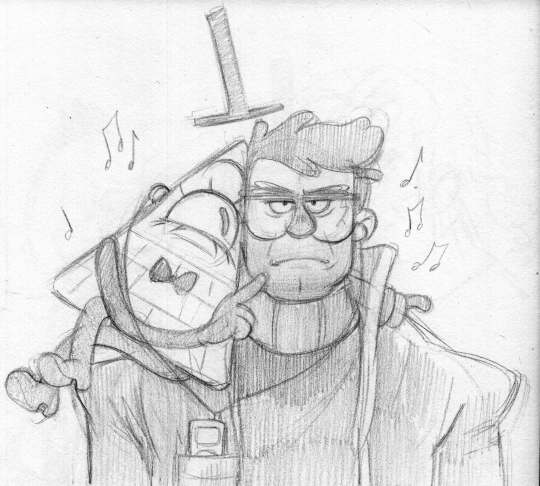
Self indulgent, because this music does not appeal to the masses at all; these songs are limited to the stuff I listen to. So I’m being VERY transparent about my embarrassing taste in music right now! Plus, NOBODY ASKED FOR THIS!!! But I hope some of these resonate with you. This is a little collection I’ve formed in my phone notes since I got into this ship a couple weeks ago.
Not a fancy spotify playlist, it’s just links to the music on youtube.
I’ve got this divided into parts:
-The Billford Songs
-The In This Moment Billford Songs
SO MUCH of their music is enemies/lovers perfection. I’ve thought about so many *killing you but also making out with you* pairings to this shit, because these songs were like, DESIGNED to be recycled for any and all love hate relationships, and still hit insanely hard EVERY TIME. So now that you have these songs under your belt, you have them FOREVER. You’re welcome. I haven’t even listened to all their music, I’m sure there’s more songs for this category that I simply haven’t discovered.
-The…Maybe…Billford Songs
My standards were kinda high for making this list. But every song is about your ship when you’re insane, right??? So these are the maybe’s. One’s I’ve thought about billford to, but maybe the lyrics don’t totally align.
Playlist under the cut! I wasn’t gonna ramble about each song but WHOOPS I DID 🤷♀️
The Billford songs:
Monophobia - Deadmau5 (Extended version, cuz it’s the best.)
THE LYRICS… THE LYRICS!!!! Definitely bill pining in theraprism.
Propane Nightmares - Pendulum
This one WAS gonna go in the maybe’s, but I convinced myself otherwise after listening to it eighty more times, and now it’s up here on top. And fuck it, this is the *self indulgent* billford playlist, so I do what I want. I go into a fucking trance when I listen to this song, so I can’t really explain 110% why this is a billford song to me, but I’ll try. Apparently, this song is about the heavens gate cult. So not enemies/lovers angst. But looking at the lyrics, you could interpret it as giving yourself to something greater, and coming to the realization that what you pledged yourself to is actually a very bad thing which will ultimately destroy you. (also, you can’t deny that there was some cult like manipulation happening with Bill and Ford. Sense of purpose and friendship.) Definitely billford-y when you consider Fords commitment to bill. And I’ll admit, when I listen to it, there is some pov switching. Because the “trail of fire”, “we will be as one”, and “bring it on home” is VERY reminiscent of bill executing weirdmageddon. So overall, my interpretation of this song is Ford feeling torn about bill, feeling regret, feeling scared, and Bill of course, just wanting to bring the dimensions together. “BRING IT ON HOME!!!!” Or I just like the song.
Rule 34 - Fish in a Birdcage
Bestie recommended this song to me. It needs no explanation.
Painkiller - The Queenstons
…NEEDS NO EXPLANATION DSKFDSKJHF It’s similar to the above, just more… scary imo. Violent. Definitely bill being a little psycho. I really love this song. It’s very recyclable too. You have it for any toxic ship now.
9V - The Queenstons
One of my favorite Lapfox/Halley Labs songs… I’m gonna give you the lyrics, it’s a bit hard to understand without them. In my eyes, it’s about betraying Ford. Also these vocals (and other music by this artist) works so well for bill because of the synthesized voice.
LoveBOMB - S3RL
This is a new S3RL song. This song sounds like a tantrum, and I really liked it when I first heard it, but it didn't fit anything I was into at the time. Luckily, bill suffered a horrible breakup, and now this song has it’s meaning.
When I'm There - S3RL
Bill thinking about joining the third dimension with Ford.
Click Bait - S3RL
I’ve listened to this one a LOT before this, and I surprised myself with how much it aligns with bill, specifically, him tricking Ford.
Space-Time - S3RL
Speaks for itself.
Sodom & Gomorrah - Dorian Electra
This one’s just funny :)

The In This Moment Billford Songs
Sick Like Me
Sexual Hallucination
This is one of those recyclable songs, but I was damn surprised at how well the lyrics suited them, because it alludes to being out of body, possession, etc.
Blood
Half God half devil
Roots
Whore
Damn it, I cant deny this one suits them.
Big Bad Wolf
DAMN IT I wasn’t gonna include this one, but I just checked the lyrics and fuck, it works. In this moment, how are you so wonderful

The…Maybe…Billford Songs
Illuminaughty - Infected Mushroom
I'm kind of grasping at straws with these lyrics, but with a title like that? Come on
The Pretender - Foo Fighters, Infected Mushroom, Turbo Remix
Three versions, for whichever suits your fancy.
Leopold - Infected Mushroom
This one has NO LYRICS, but it has this buildup that sounds really cool, and it has an abrupt decrescendo. Reminds me of their "friendship" and how it all came crashing down.
Idolize - Dorian Electra
Hmmmmm, I just like Dorian. But the idolization thing works for obvious reasons.

That’s it! Hope you enjoy. Maybe I'll do an expansion pack of sorts if I find enough songs for a part 2.
#billford#billford playlist#gravity falls#bill x ford#ford x bill#stanford pines#bill cipher#playlist#gravity falls playlist#billford fanart#gravity falls fanart
2K notes
·
View notes
Text
it easy change my voice on AAC.
easier than mouth speak people.
go to setting. go to voices. look, there entire lists. you can try them on like coats in mall. if don’t like them, in press of button you can have something new.
some, can change pitch. can make deeper. can make higher. can make faster. can make slower.
world in your tablet.
it hard change my voice on AAC.
my AAC. is my voice. is identity.
can change with press of button. but not so easy. we have history. my identity entangled with how AAC sound. how i sound.
change voice feel like loss of identity. feel empty. feel lost. feel like line carve in stone, divide me in past and future.
it hard change my voice on AAC.
do speaking people have to choose from limited list of pre synthesized voices? do speaking people run into other speaking people with same. exact. voice as them, same pronounciation errors, same annunciations, same tone, same exclamation?
do speaking people have to compromise within self and share that same voice with other people, a voice that yours but never fully yours?
it hard change my voice on AAC.
mouth speak people. as they age. mature. grow old. switch context. voice naturally changes. voice grows with them.
mine stops. mine frozen in time.
transition from one life stage to another. should i change a voice? to make pallatable for people around me, more professional, more mature, more “taken seriously,” but lose self in process?
it hard change my voice on AAC.
many choices for “standard” (< white) american (< USA) english. many choices for british english. some choices for spanish.
where my diaspora accents? where my languages?
can my friend not speak their mother tongue?
- thank you for give me outlet for voice, but you all that i have
from nonverbal full time aac user
(as in nonverbal all the time)
1K notes
·
View notes
Text

Some basic anatomy notes on kee, one of the sophonts in Sea of Spires. They are the most common sophont in the Keeland biotope and, after the establishment of kee-gardens in the Terran biotope hundreds of years after first contact, are the most common Keeland sophont outside of their biotope.
Kee bodies are divided into six segments, each with a single limb and spiracle, arranged in an alternating pattern around their central nerve cord. This lends their bodies a slight asymmetry. Their first segment is most derived, with the limb adapted into a jaw and the spiracle adapted into a "vox" organ capable of synthesizing a wide range of sounds. In a typical kee the fore vox is only present on the right side and a second smaller vox sits on the left side of their terminal segment. In both the front limb and wing segments the spiracle remains intact as a breathing organ.
Also pictured is cranial differences between N and T-type kee, and genitalia differences between males and females. Both sexes have brightly colored flanges surrounding their cloaca for display, similar to the display flanges on their face. The main external difference is that males have brighter flanges and a pair of claspers flanking the cloaca.
N (nurturing) and T (territorial) type kee have no genital differences, but posess major morphological differences in the rest of the body. T-types have very brightly colored heads and wings, along with larger wing-claws and a more prominent beak spike. They are more aggressive and prone to wander, tending towards protecting the edges of a kee flock's territory and participating in foraging activities. N-types tend to fill more of a homemaker roll, raising and guarding young and maintaining their nests.
489 notes
·
View notes
Text
The Big Guide to Humans: Skin
First: Yes, it is true that humans have whole-body stripes that not all species can see. Yes, it is also true that they themselves cannot usually see them. They are an artifact of pre-natal development and are present from birth. They usually have no significance, though some skin abnormalities may follow their usually-invisible path (or may make them visible).
See body art for questions about deliberate skin markings.
--- Human skin is a soft yet durable covering made of stretchy proteins. It provides protection from water loss, pathogens and UV radiation, insulates their body against external temperatures, synthesizes a chemical they use to make their skeleton, and is home to humans' abilities to feel touch and to cool themselves.
The skin is made up of layers, further divided into more layers, and the different functions are distributed within them. The details of these layers are not necessary to know for working alongside humans; suffice it to say that the topmost layer may noticeably flake off in very dry environs and this is mostly harmless but irritating to the human, oozing a clear but yellow-tinted liquid (see immune system) represents a minor but disproportionately painful injury of having scraped off the uppermost layers, and bleeding (oozing or gushing a red opaque liquid, see circulatory system) means the injury is deeper still.
Skin that has been damaged can usually repair itself over time, although it may take assistance (externally binding the wound shut, for example). Deeper wounds are likely to scar, that is, to be repaired with a tougher skin of different appearance. This is not the same thing as a callus, seen on the base of human feet and sometimes on the fingers, in which the skin grows thicker and tougher to resist pressure injuries.
It is normal for tiny hairs to be present in the skin over most of the human's body, regardless of sex or gender. Both sexes may have prominent hair on their faces or torso after puberty (see lifespan and development), but it is much more common with men.
If the human is warm (likely if ambient temperature is above melting point of gallium) or has been exerting themselves, they may "sweat." Salt water will leak in small amounts from all over their skin, concentrated on the forehead/under their hair, in the soft socket under where their arms meet the body, and around the external genitalia, to make use of evaporative cooling. They may begin to smell strongly; they usually find this smell unpleasant. If the human is cold, or in some scary situations, the tiny hairs may stand up instead of laying flat. This is an evolutionary artifact from ancestors with thicker fur and no longer helps to keep them warm or frightens predators.
Humans' sense of touch is very sensitive, especially on their hands, but outside of their hands it is sometimes not precise. You could lay one of their hairs on a surface and ask them to find it by feel, and they would be able to do so with their hands even if the surface was not smooth. If you dropped a single hair on the bare arm of a human, they would feel it, but they would not be able to pinpoint its exact location without seeing it.
!! Due to tiny dangerous creatures on their home planet, humans will usually immediately attempt to remove the source of an unexpected small light touch, often by swiping at it with a hand or by jerking their body. If you are fragile or tiny, and this would damage or dislodge you, get their attention before physical contact. !!
While humans can only see a narrow portion of the electromagnetic spectrum, they can sense somewhat beyond that band with their skin. Infrared can be sensed as heat, especially at short distances. Ultraviolet can be sensed over time, as specialized molecules in the skin cause cells to sacrifice themselves to prevent it from penetrating farther into the skin. However, by the time the human has noticed the feeling of this cell-sacrifice, the skin is likely to be damaged enough that it will darken and/or become red and sensitive soon (within the timespan of a human sleep cycle). Humans with naturally darker skin can generally withstand ultraviolet radiation for longer periods of time before becoming damaged. When the darkening or reddening has passed, small brown marks called "freckles" will often remain, usually for the rest of the human's life. If the skin has reached the red stage, as the color returns to normal the damaged skin may come off in thin sheets as though the human is molting. Do not offer assistance with removal unless they ask.
Human skin is covered in bacteria, viruses, and fungi that are mostly harmless to them. This is covered in more detail under microbiome with some pertinent points under mating.
392 notes
·
View notes
Note
Of course!
I warn you though I am way more uncontrolled neurodivergent than people tend to expect so if we talk synths BE PREPARED.
If things go south and I get stuck on the exact combination of digital and analog sections or my OC-like ideas for divide down string machines, you may have to take drastic action.
🎹
💖💖💖
can you add me to the synthesizer community plsss I promise to post good
Sure, but you might need to hit me with another message on which specific community we're talking about because it might be my ADHD obliterating my memory as usual but I definitely forget that I was in a synth group on here.
6 notes
·
View notes
Text
Problem 1: I want to write the kinds of books I like to read, and these are often driven heavily by the relationships between characters, not the Looming Threat of Some Bad Guy, and I wasn't sure how to translate that
Problem 2: All the plotting advice ever written seems to assume you're either an aspiring romance novelist or that you want to write the next Star Wars
Problem 3: In pursuit of my goal, I have encountered many, many plotting methods that I only sort of grasped
Solution: I sat down with a guide to Dan Harmon's Story Circle, Save the Cat! Writes a Novel, and K.M. Weiland's various blog entries, and synthesized them into a comprehensive plot wheel that I understand perfectly and makes NO MENTION of The Looming Threat of Some Bad Guy. It's color coded. Multiple people tried to armchair diagnose me with autism when I posted about this elsewhere. Can't imagine why.

Now I ramble:
I started with the Story Circle because I really thought I was gonna be doomed to writing Sherlock Holmes-esque short stories for the rest of my life, so I wanted to study TV format. It's fine, but it's a little vague. However, the way it talks about CHAOS vs ORDER and LIES vs TRUTH specifically, I found extremely helpful. The Story Circle's biggest influence on my wheel is all that highlighter and the words in boxes, as well as the words in all caps.
The other thing about the Story Circle is that it implies, by virtue of splitting up the Circle into perfect 8ths, that each section (YOU, NEED, GO, etc) takes up the exact same amount of story, which is not true
By contrast, Weiland divides stories into (roughly) 9 equal parts, thus assigning them all a spoke on the wheel (with the very first and very last part sharing a spoke, hence 9). That's why the wheel is divided evenly and the Story Circle sections are scattered unevenly across the circumference.
I called on Save the Cat the least for this enterprise because, after study, I found it the least helpful. I was able to marry each of its "beats" to one of Weiland's sections, and I used those descriptions to inform how I filled in that information. (For example, under 'renewed push,' Weiland is somewhat vague about what should happen, but STC includes suggestions for contrasting how the preceding plot point ended.
And there we have it! I can't say exactly how long this took me because I did most of it while on the clock at work. Maybe 8-12 hours? Not too bad at all because I already had comprehensive notes on everything.
#delphi washington#idek if this would even be helpful to anyone because it's so small and hard to read. like i was gonna throw some writer tags on it but idk#ugh whatever message me if you want me to try to send it to you#writeblr#the warped maniacal mind of wizard glick at work
52 notes
·
View notes
Text
Dungeons & Dragons Content Creators Summit and Being a Corporate "Shill"
I was invited to attend the Dungeon & Dragons (D&D) Creator Summit in early April, and I happily accepted. I initially wasn’t going to publicly say anything about attending because I didn’t see any need. However, in the last week, numerous conversations on various internet platforms have both tacitly and overtly accused anyone in attendance of being a Wizards of the Coast (WotC) “shill” or “clout chaser” who will agree with anything WotC says because they:
Paid for attendees’ travel.
Included a per diem to cover meals and incidentals while traveling.
Have given past promotional materials to many of the people in attendance.
May offer us further financial opportunities in exchange for refusing to challenge currently proposed ideas and materials.
This is not only reductive, but further divides a community still reeling in the wake of the recent uproar over the leaked, proposed Open Gaming License (OGL) revisions which resulted in targeted harassment of individual studio employees and content creators, especially those of marginalized identities, despite the fact that most of those who were harassed had no authority over the business decisions which caused the initial uproar.
What is a Summit?
Summits are opportunities to have open dialogues and share opinions towards a common goal. They’re common in academia and politics. Good summits are about synthesizing new ideas and challenging old ones. They’re often heavily structured and moderated with specific strategic goals, and the good ones deliberately invite people with vastly different perspectives on a topic.
To put it mildly, summits aren’t something to organize if you want people to pat you on the head and tell you that you’re doing just great! They’re often extremely heated because people passionately and vehemently advocate for their perspectives and priorities which may be in direct opposition to others’.
What’s different about this summit is that it ostensibly possesses a level of transparency which I haven’t experienced before. Summits are often closed-door conversations, so that the people in attendance can speak candidly about topics or strategies currently in the planning stages.
My invitation email specifically stated that the goals of the D&D Content Creator Summit are:
To gather feedback on how the D&D team can improve the experience of making D&D content.
To gather feedback on upcoming products such as the D&D Rules Update and D&D VTT.
For content creators to have more opportunities to interact with D&D staff in-person.
The email invitation specifically stated that this summit is based on consistent feedback WotC has gathered since PAX Unplugged 2022, and that this is a “first step.” Additionally, no one in attendance will be expected to create any content regarding the summit, WotC will not be taking any footage, photos, or recordings of the summit for any purpose, and any information shared with attendees may be shared with the community. That last part is notable, because it means that people in attendance – all of whom have platforms of varying sizes – can frankly offer feedback now and in the future on what is discussed, as well as how D&D incorporates the feedback.
Who is Going? Why Were They Invited?
I don’t fully know who is going. I also don’t know why certain people were invited and others weren’t. No one I know of – outside the organizers and those who helped them – does, and anyone else is likely acting on various degrees of speculation. I strongly suspect questions about inclusion and exclusion criteria will be some of the first things asked at the summit. I’m especially curious about this criteria, given that content creation isn’t my primary job – consultation and education on mental health are, though that role sometimes extends to matters of content creation.
Some creators announced their attendance publicly out of excitement at being included or with the intent of gathering questions from their communities. Some creators kept their attendance privately known only among industry members and friends. Of those I know who have kept their attendance private, the fear of being the target of harassment is a commonly cited reason, but an even more common reason was a desire to attend and push for change.
Many of the people I know who plan on attending are staunch advocates for various topics such as inclusion, accessibility, and representation of marginalized individuals in D&D and other tabletop roleplaying games (TTRPGs). Some of them have directly consulted with WotC before and offered frank feedback as part of their consultant role. Other attendees built their platforms on advocacy and haven’t been shy about calling out perceived missteps. In short, they’re not people who are afraid to voice their opinions.
It’s worth noting that – of the attendees I know – nearly every single one is marginalized in one or multiple ways, whether it’s ethnicity, gender identity, orientation, neurotype, medical/disability status, or a variety of other identities. Nevertheless, who is and who isn’t in attendance is absolutely worth noting, once we have all the facts. Who has a seat at the table is always poignant and important feedback.
Isn’t Your Objectivity Compromised by Receiving Compensation for Attendance? Coercive Rewards and Role Clarity
Some of the online discourse supposes that those of us in attendance will kowtow to WotC’s efforts because they paid for travel, offered a per diem, and many of us have received promotional materials in the past on which we’ve built content. Is that true? Is our objectivity compromised? Probably not, and here’s why. In the psychology field, there are two concepts we talk about frequently: coercive rewards and role clarity. Coercive rewards are often discussed in terms of psychology research. Participants in research are generally compensated in some way for their participation, but the compensation cannot be so great as to compel or coerce them into saying yes when they might otherwise refuse. To give some perspective on the level of compensation, I live in the same geographical region as WotC headquarters, so travel costs aren’t covered for me. I am still receiving a per diem for food and incidentals during the summit. However, I’m taking two days away from both my day job and my private practice. While I can reschedule some of my clients, I won’t be able to reschedule all of them, so I’m going to end up losing money by attending, and I’ll have to make up other work at my day job. To put it bluntly, per diem and travel costs (if I were traveling), and occasional promotional material are not enough to coerce an endorsement from me, especially if I think something is actively harmful and the goal of the summit is to offer critical feedback.
Instead, my attendance is driven by my love of the D&D community, what it’s meant to me, and my desire to help improve that community and help it thrive by bringing as many people to the table as possible. Most of the people I know planning to attend are in similar situations and of similar mindsets – taking time off from work and essentially losing money because the goals of this summit are important to them. The travel compensation and per diem simply help to minimize losses for some people.
One summit attendee I spoke with noted that there is also an equity issue at play. Without offering compensation for travel and a per diem, it limits attendance to those of a certain socioeconomic level. That negates the possibility of wider community feedback. Also, how many memes and Twitter threads exist about creators being “paid” in exposure? Offering compensation hints to me that WotC takes this feedback seriously and is willing to treat everyone in attendance like a professional.
Beyond pure dollars and cents, many of the summit attendees are either immunocompromised or have family members who are. They are literally taking health risks to attend because they believe in the purpose of this summit and improving the D&D community as a whole. If that’s not a sign of how dedicated some of the attendees are to improving the community, then I don’t know what is. Now let’s talk about role clarity. There are a lot of different jobs in psychology, just like there are in games and content creation. In psychology, a person might be a therapist, evaluator, expert witness, consultant, teacher, researcher, or any number of other roles. To perform any of these roles effectively, they must be crystal clear on what that role entails and what is outside its scope. It’s the same thing here with the summit. Based on the invitation email, it seems that the role is similar to one of a consultant – to critically evaluate what is presented and offer feedback based on one’s experience and expertise. Thankfully, this is a role in which many of the attendees I know have a wealth of experience.
Some readers might retort with, “But you might get other jobs by being there!” Yes. Yes, we might. This is a professional invitation with an expected, professional role, and if we perform that role well, we might get future professional opportunities. That’s what should happen when one performs their job well, and it should be true regardless of the industry and context. However, the reality is that those jobs are both hypothetical and not likely to happen overnight. It's more likely that these jobs would be one-off consultations, collaborations, or the like.
While jobs like that are appreciated and welcome, they are not steady employment. Summits are not generally real-life versions of Willy Wonka and the Chocolate Factory whereby the one attendee who is most skilled and virtuous will be given control of WotC. Anyone who plans on attending with the fantasy that they will be instantly rewarded with their dream job is probably going to be disappointed.
Is This Summit Solely to Do Public Relations Damage Control?
Ignoring the fact that a lot of the people attending this summit are generous with their opinions, for good or ill, some in the community have asserted that the D&D Content Creator Summit is simply WotC’s attempt to repair damage to the D&D brand in the wake of the bad business decisions during the recent OGL controversy. Events like this summit take a long time to organize, so I actually believe the email I received when they said that this is based on feedback they’ve received from as far back as late November/early December 2022.
At the same time, WotC would be foolish to avoid using this as a step towards what they pledged they would do at the tail-end of the OGL controversy: obtain and incorporate direct, community feedback. After all, the ability to follow through on proposed behavior changes is what we want when we have problems with people and companies, right? If the goal is to simply do damage control after a public relations nightmare, inviting a bunch of opinionated people with platforms to give feedback isn’t great if one doesn’t intend to actually listen.
No one attending has forgotten the OGL situation, regardless of where they stood on it. If WotC is doing things well, they’ll learn that from the feedback. If WotC is going in a direction that irks folks at the summit, they’re going to learn that too, and if it’s the latter, that’s not going to help WotC, because the folks in attendance have platforms and haven’t signed any non-disclosure agreements.
Final Thoughts
All in all, what is the D&D Content Creator Summit going to be, and what is going to come out of it? I don’t know. I don’t think anyone does.
Much like in D&D, we can’t know the outcome of things before the action. That said, there are going to be a lot of talented, caring, observant, insightful content creators present asking hard questions and offering critical feedback. Content creators, especially advocates like those I know are going, work damn hard to produce what they do, and it cheapens their hard work, especially the advocacy work, to call them corporate shills and assume that they’re going to agree with anything presented. Agreement isn’t the assignment. Neither is the assignment for us to listen to WotC. The assignment is for WotC to listen to us.
If we want to see change from people and companies, we have to be willing to note when they take steps to change, even if it’s just the first step. That’s not to say we can’t be critical at the same time. We should be critical, in fact, but critical isn’t the same as unyielding vitriol, universal condemnation, and us-versus-them. Critical means noting both mistakes and successes and pushing for constant improvement. No person or company is going to go from badly messing up to doing everything perfectly.
As far as I know, WotC is trying something new with this summit, and it represents a shift in how they produce their products. I don’t know if it’s going to lead to sustained changes, but I’m willing to see if it does. I hope it does. More than that, I hope it’s exactly what they said it is: the “first step” in a new strategy of involving the community. My biggest fear is that if they see overwhelming, unflinching condemnation of anything they attempt, especially when it’s violence and threats from the community they’re trying to get input from, then they may stop trying to engage at all, and then we’re left with only anger and unfulfilled hopes.
559 notes
·
View notes
Text
okay @deathsbestgirl asked so here is my little essay on why folie a deux is THE quintessential x-files episode. the distillation of everything that made it great.
so. first of all. imho, the best episodes/monsters are the ones who draw from a genuine human fear, turning our small private anxieties into full-blown paranormal horror. who among us hasn't felt like our job was sucking the life out of us, our boss was a monster, and every day in the office you inch closer and closer to being a zombie? in folie, it's TRUE. imagine the terror of seeing your coworkers reduced to walking corpses, no one believing you, knowing your turn is coming. the skittering noises creeping closer and closer. you, helpless at your desk. (also the late-stage capitalism certainty that somehow your corpse will be forced to work even after you're dead.)
then we get profiler!mulder, gently mocking himself ("monsters? i'm your boy") - showing off his brilliant mind as he dissects lambert's manifesto, empathizing with him to protect the hostages even as he endangers himself. he goes even further after lambert dies, despite (or perhaps because of) the fact that he was written off as a madman, putting together the pieces that no one else even cared enough to look for. this is mulder at his CORE. the man who believes, who wants to believe, who doesn't let the label of "crazy" stop him from opening the box to see what's inside and decide for himself, who puts justice and truth above reputation and even personal safety. no one takes him seriously, he knows EXACTLY how it feels to be labelled and dismissed, and that makes it all the more important to find the answers.
meanwhile scully is doing the exact same thing, but in her particular flavor. digging through the files to find the phrases that rang out in the manifesto. protecting mulder during the hostage situation by sending in disguised SWAT cameramen (because she remembers duane barry Very Well, and if she can't be in his ear this time, she'll send in someone else to be her eyes). she doesn't want to do the autopsy, she doesn't want to see; but she is so curious and so unself-consciously committed to understanding the world through the lens of science that once she starts to see the pieces, she cannot not start putting them together. THAT is scully at HER core. she also covers for mulder when he goes off on his own, because while she may not believe him or stand behind his methods, she knows he only does this because his heart is in the right place. and if there's one thing she has to protect, its his heart.
then. oh. then. we get the msr-iest line to ever msr. one in five billion. if ever there was a beating heart to the x-files, it is that. i trust you, you trust me, and when we trust in each other god himself cannot stand against. in an episode about not knowing if what you're seeing is what is true, the way they SEE each other, understand each other in this scene is almost painfully poignant.
(i hope when pincus looks back at the time he was nearly caught, he recognizes the poetry inherent in stumbling across the only two coworkers he could never divide.)
finally, the ending. what always makes this show work, to me, is the way mulder and scully come together, bringing their disparate viewpoints and opposing investigation methods and ultimately synthesizing one truth, one solution that saves the day. seeing things the way the other sees, so both can understand. here, it is literal. scully comes to it from her own direction, finding the science to support mulder's theories, and that is what allows her to see the truth of what he sees. (field trip does something similar, but that time it goes both ways, buuuuut that is also an essay of its own.)
so, yeah, what makes this episode x-files condensed into its purest form: our characters charactering perfectly, a premise that is both grounded and terrifying, the idea that it is only ever the two of them who could figure this shit out because they're so perfectly matched.
even the phrase folie a deux IS the x-files. that basement office is a bedlam, population: 2. a madness only two can ever hope to share.
53 notes
·
View notes
Text
Someone probs wrote about this before, but it’s absolutely bonkers how Aof’s Bad Buddies and Our Skyy crossover with ATOTS put men’s bisexual/pansexual experiences in conversation with gay experiences.
You get Pran and Phupha and even Tian all existing to some extent as gay characters—and I don’t say that because anyone specifically uses that label (only Tian really goes near there). In fact, I don’t even say that because of the gender they’re attracted to! There’s more to their gayness than that. They’re gay characters because all three of those characters exhibit major signs we associate with effeminacy and, more importantly, its early suppression by others, which leads to the shameful self-repression we see in their present day incarnations. They all have softer sides—music, art, gentleness—that they tuck away privately, and they each have clear examples throughout their stories of people telling them that they need to eliminate or at least hide that part of themselves. And these interests and expressions are not just subtext about sexuality here, they are specific markers we culturally expect to see alongside gayness. And the suppression, or lack there of, of those effeminate qualities is a significant gay milestone.
Pat doesn’t have that experience, though, which I think is genius from a writing and queer theory perspective. The thing about the LGBTQIA+ grouping is that it’s a very potent political grouping, but the experiences of each letter within that acronym are distinct, and often it’s precarious to bring up the differences. However, with Pat’s bisexual characterization, we see how it can be productive. Because Pat’s embodiment, interests, and sexuality contained more aspects that were socially acceptable, he did not experience the same type of suppression as Pran, Tian, and Phupha did early on. He never needed to develop coping mechanisms that involved self-denial. Therefore, he’s comfortable being expressive with his more feminine side and his affections. He doesn’t have the same sense that his sweetness puts him at risk of anything. This openness provides a model for Pran in Bad Buddies and Phupha in ATOTS to explore releasing some of their self-control, anxiety, and shame to share the sentimental parts of themselves (Tian’s whole arc in ATOTS is about coming to terms with this more feminine heart inside of him—RIP Torfun 😢).
I think one of the lessons we’re supposed to glean from Pat is that any person, queer or not, could be that open and comfortable with the full spectrum of gender expression, from fist-fighting to hugging your nong nao doll over a crush, if they were given full support by their fams. Since that perfect world doesn’t quite exist, this is a really unique secondary message we get about the potential of reaching across the divides and growing from other groups within the LGBT acronym. Of course, no character is a stand-in for an entire group. Not all bisexual and pansexual folks escape childhood without suppression of their gendered ways of expressing themselves, and they have unique societal and internal challenges that come with their sexuality. But it’s okay to acknowledge, as Bad Buddy and ATOTS do, that many (but not all of course) exclusively gay men have interests and gendered styles of expressing themselves evident earlier in their lives that make them a target for shit, which leads to a specific loneliness-inducing style of relating to themselves and others. P’Aof and his team, instead of comparing those experiences with bitterness (which is what I’ve often felt inclined to do in the past tbh) asks what possibilities exist when these people can understand one another. It’s also somewhat symbolic of the possibilities that occur when the BL trope of ‘gay only for you’ is, not put in contest with lgbtq media, but instead synthesized—which is what P’ Aof has explicitly aimed to do for his whole career.
#bad buddy#atots#aof noppharnach#1000 stars#patpran#phuphatian#earthmix#ohmnanon#our skyy 2#I am specifically talking about cis men here#because I think that queer women have unique types of experiences too#alongside other folks in the rainbow#but I don’t think bad buddy or atots is really putting those in conversation#but they def can be and could be really productive#just not in this mini essay thing lol#Thai bl#bl drama#thai ql#ql drama
32 notes
·
View notes
Note
I think there are a lot of questions about the universe that need resolving. Why is it that Gamma radiation works the way that it does.
Why does it cause you to create a second personality? And is it the only one resting in your head?
Okay.
I'll do my best to explain my answers properly.
To understand how gamma works you need to know where it comes from.
All radiation comes from nuclear energy, that's the source. Nuclear energy is created when there is a spontaneous change in the atoms nucleus (this can either be a fission: it splits into two or more parts, Or a fusion; nuclei combine into one), making it unstable and therefore radioactive.
With this spontaneous change, like any movement that requires energy to work, some of that energy isn't used and is let out instead, it can be let out in various forms, sometimes thermic and sometimes in waves. This is what we call radiation.
There are four types of radiation, all with varying types of velocity and force (the strength it needs to penetrate through something); Alpha, Beta, Neutrons and electromagnetic waves, like gamma rays.
Gamma rays are one of the strongest types of radiation, it moves at the speed of light and can penetrate through nearly anything.
It has the ability to divide cells and kill them.
I'm not entirely sure how what happened to me happened, it should've killed me quite frankly but my hypotheis is that my body adapted to the radiation and accepted it, worked with it to somehow make a way to synthesize the emotion I have the hardest time dealing with; anger.
//My science classes really locked in with this lmao.
16 notes
·
View notes
Text

[Image 1 ID: A flag with eleven stripes, they are from top to bottom, muted dark purple, indigo, electric blue, dark gray, red, yellow, green, dark gray, magenta, deep dark magenta, very dark purple. End ID]
Cybescential: A gender related to extraterrestrial life, the golden record, science fiction, cyberpunk, synthesizers, cyborgs and cybernetic enhancement, wires coiled tightly together, the patterns on a circuitboard, blacklight and its florescence, particularly magenta, and glowing lights.

[Image 2 ID: A red divider with two devil horns on each side and orange text in the center that reads, "Team Villains".]
revenge on @dragonpride17! 7 points? (5 base + 2nd in chain)
tagging: @coinfight
#coinfight2024#Cybescential#neogender#theme: technology#theme: space#theme: aliens#theme: science#theme: media#theme: colors#theme: glowing#;#mogai#mogai coining#mogai friendly#mogai flag#mogai safe#mogai term#mogai label#liomogai#liom#liom coining#liom label#liom term#liom safe#liom friendly
22 notes
·
View notes
Text
As annoyed as I am that we don't actually get any more details about Kusu himself (how was he chosen to bear the sword, did he have a life before this, does he have any hobbies in between slaying mononoke, DOES HE HAVE A THING FOR KAYO (actually I'm not taking no for an answer on this one), how does he feel about his job, what happens if he's "decommissioned" and he's no longer needed as the medicine seller?) I do love that we get a better idea of the logic informing the worldbuilding now.
Japanese culture is influenced by an inseparable amalgamation of Buddhism, Shintoism, Taoism and Confucianism, all of which are twisted cultural knots of their own, but it's interesting how they're being specifically synthesized here. It seems to be a primarily Buddhist/Taoist base with some Confucian principles influencing Shinto aspects with a healthy dose of imagery from LITERALLY EVERYTHING (the hieroglyphs on the exorcism swords box??) to create a unique mythology schema. In the interview Nakajima-san uses a lot of terms I couldn't find any information on but he does describe the basic logic as "Mukyoku gives rise to Taiji, Taiji is divided into Yin and Yang, and both sides give birth to both sides". Mukyoku is the Chinese philosophical concept of Wuji (pole/infinity) and Taiji is the concept of basically Life, The Universe, Everything, including how all the aspects of yin and Yang influence each other. Big stuff!
Tbh I'm not a huge fan of manga or anime having this kind of rigid numerical/hierarchical structure. I get that it's how a lot of east Asian philosophies and religions are organized but explaining that hierarchy often becomes the focus of the story instead of exploring the characters within it. Fortunately it seems like Nakamura-San is still interested in those personal stories (EXCEPT FOR KUSU'S DAMN IT) so I think he just felt it was necessary to explain this so that all the discrepancies between media made more sense.
Anyways I'm praying we get a story bible released someday.
39 notes
·
View notes
Text

This Skyscraper is New York Blue
The form of this building is unconventional. While it features a traditional setback at the base of the office section, the design departs from convention with three volumes that recess at loggias instead of stepping back. This approach, though rare, has some precedents—One Madison in New York, the Silberturm in Frankfurt, and Calatrava's Turning Torso in Malmö offer similar gestures. The result is a visually striking and highly functional design that includes large decks for fresh air, with additional balconies on alternating floors to ensure outdoor access is easy.
As FXCollaborative’s Gustavo Rodriguez explains, the goal was to "break down the massing so it becomes more digestible." They aimed for a design that felt personal, giving tenants the ability to say, "That’s my floor" or "I’m two floors above that," fostering a sense of identity and ownership within the larger structure.
By 2023 standards, the building has remarkably little glass—just 33% of the facade. The rest is brick, carefully patterned and paired with pre-cast concrete spandrel panels. Inspired by the decorative brick piers of Ralph Walker’s designs, the facade isn't flat; it features a pleated brick pattern designed to interact dynamically with light. Avoiding disruptions at the building's corners posed a challenge, so the team created custom hand-pressed chamfered bricks to ensure a seamless look. This attention to detail extended even to the choice of brick shade, with Rodriguez noting, "We needed a New York blue; it couldn’t be a Texas blue or a Mexico blue."
The design also incorporates traditional methods, wrapping the building in elegant sunshades. These sunshades, reminiscent of divided-light industrial windows, maintain the visual integrity of the 16-to-18-foot-high windows while only attaching to mullions between panels. This approach allowed the use of low-reflectivity glass, which significantly boosted the building's energy efficiency.
Thanks to these thoughtful design elements, FXCollaborative’s office in One Willoughby earned the first LEED Platinum v4 Interior Design and Construction certification in New York City and the highest-scoring LEED v4 Commercial Interior Design and Construction rating in the country.
FXCollaborative Brings it All Together
FXCollaborative embraced an unconventional approach for One Willoughby, adding an unusually high number of exterior columns—spaced every 15 feet instead of the typical 30. This decision allowed for fully unobstructed, loft-like floors spanning 140 by 60 feet, creating expansive open spaces without sacrificing structural integrity.
The design also includes internal open staircases that connect the firm's three floors, a feature that can be replicated on other levels throughout the building. The floorplates, while open, are modest in size. Even before the COVID-19 pandemic, the firm questioned the value of massive floorplates. Gustavo Rodriguez notes, “A lot of people realize they don’t need 300 desks; they need 150. They’d rather have a smaller floor plate where they can see each other than one that wraps around a huge core, where visibility is limited.”
Flexibility was a key consideration throughout the design. Larger tenants can connect office floors with staircases, while smaller tenants can easily subdivide spaces. Now, about 60 percent of the building is leased. Before the pandemic, only FXCollaborative and a public school had committed, but the building has since attracted tenants like the Architectural Research Office, the Ms. Foundation for Women, Propel, and Gemic. Additionally, a loggia-level amenity floor provides an extra incentive for potential tenants, as highlighted by Adrian Madlener in Metropolis.
Rodriguez describes the building as a culmination of FXCollaborative’s recent work across various projects, saying, “This is the first time we were able to bring some of our areas of exploration into one building. It was a chance to synthesize all of our ideas.”
The only challenge? “The biggest trouble,” Rodriguez quips, “is having 120 architects as your clients.”
#1WSQ#Willoughby Square#Willoughby#Brooklyn#new york city#new-york#new york#newyork#nyc#ny#manhattan#urban#city#usa#United States#buildings#travel#journey#outdoors#street#architecture#visit-new-york.tumblr.com#One Willoughby
14 notes
·
View notes
Text
Lost, but Not Forgotten: Two Kinds of Women (1922)
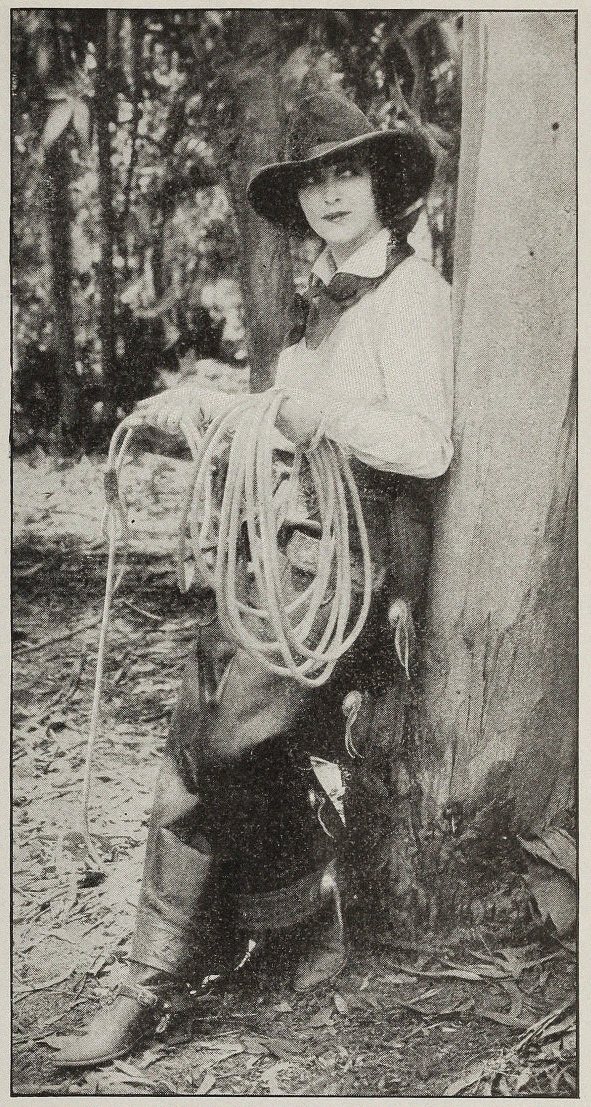
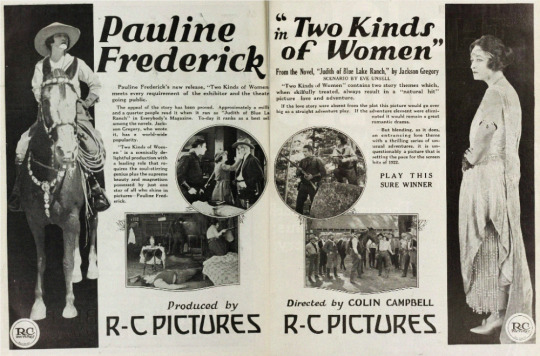

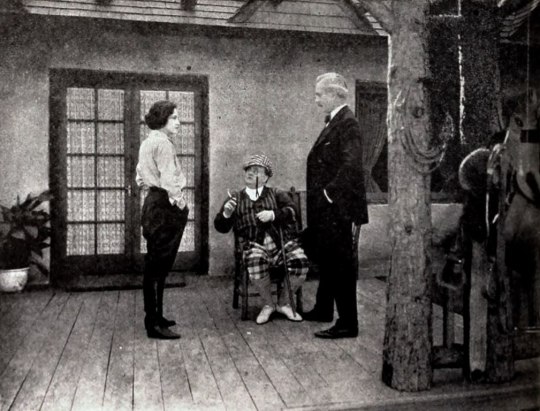

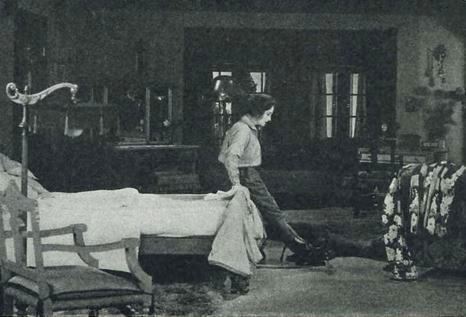

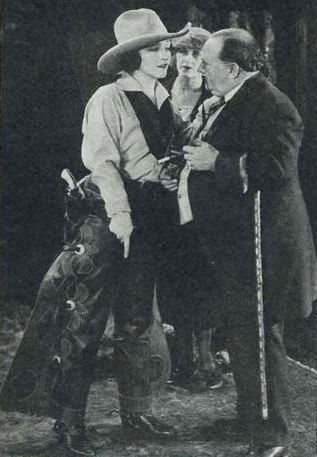
Alternate Title: Judith of Blue Lake Ranch
Direction: Colin Campbell & George C. Bertholon (assistant)
Adapted Scenario: Winifred Dunn
Based on: Judith of Blue Lake Ranch by Jackson Gregory (novel)
Production Manager: R.J. Tobin
Camera: Dev Jennings
Editing: Pauline Frederick (editing supervisor), Colin Campbell, & Dev Jennings
Studio: Robertson-Cole (Production & Distribution)
Performers: Pauline Frederick, Tom Santschi, Charles Clary, Dave Winter, Eugene Pallette, Billy Elmer, Jack Curtis, Jim Barley, Sam Appel, Otis Harlan, Clarissa Selwynne, Jean Calhoun, Tom Bates, Lydia Yeamans Titus, Frank Clark, Bud Sterling, Elise Collins, Joseph Singleton, & Stanhope Wheatcroft (not mentioned after release, but listed during production: L.C. Shumway)
Premiere: Opened at Loew’s State Theatre on 3 February 1922; preview screenings for reviewers in NYC, 27 January
Status: presumed entirely lost
Length: 6 reels, ~6,000 feet (a few sources say 5, most say 6)
Synopsis (synthesized from magazine summaries of the plot):
Judith Sanford (Frederick) inherits the sizable Blue Lake Ranch after the unexpected death of her father. Upon her arrival, she discovers that the ranch’s manager, Trevors (Clary), has been systematically undermining the value of the ranch. Judith confronts him, fires him, and wings him with her pistol as severance.
The horse foreman, Bud Lee (Santschi), had suspected Trevors’ dirty dealing, but questions if he can work for a woman. Regardless of his doubts, Bud respects Judith’s goals and remains loyal to the ranch.

As there are still men working on the ranch loyal to Trevors, Judith’s employees are divided. One of Trevors’ hires, Quinnion (Curtis) rebukes Judith and suggests she can’t even ride. She challenges him to bring her a horse he thinks she can’t ride. Judith successfully rides the wild broncho and Quinnion is cowed, leaving the ranch bitterly. The incident wins Judith the respect of the men, including Bud and Carson (Pallette), the cattle foreman.
Judith’s next point of action is tracking down the staff Trevors ousted, most importantly the ranch vet, Doc Tripp (Clark). Tripp returns and uncovers that disease-infected animals have been intentionally introduced to the ranch’s stock. Judith runs Trevors’ vet, Crowdy (Appel), off the ranch.
Hampton, a city boy and one-third owner of the ranch, is unhappy when he hears of Trevors’ firing and decides to pay a visit to Blue Lake. (In reality, he’s dodging his creditors.) The visiting socialites are rankled by Judith’s cowgirl togs and no-nonsense demeanor. Alternately, the ultra ladylike Marcia (Calhoun), Hampton’s fiancee, finds a new devotee in Bud.
On the night of their arrival, Judith learns that the employee she sent to collect the payroll has been robbed. Bud races to the bank overnight to return to pay the staff the following day. As Bud is on his way back, his horse is shot out from under him, but he manages to reach the ranch just in time.
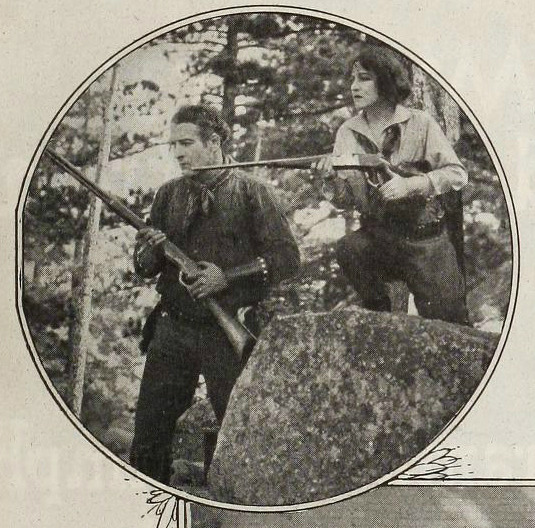
That night, Bud and Judith set out to track down the bandits and recover the stolen payroll. At a cabin in the mountains, they catch the robber after a shootout and find it’s the discharged vet, Crowdy. They agree to stay overnight to guard the injured Crowdy. To pass the time, Judith pulls a book from an unexpectedly well-stocked library in the cabin and sees that the books belong to Bud! They’re interrupted when Quinnion attacks to save Crowdy and another shootout ensues.
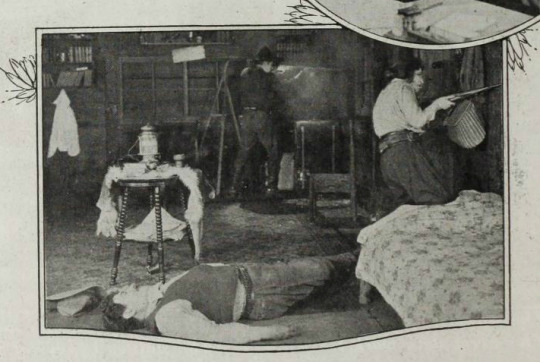
Fortunately, Judith’s absence from the ranch was noticed by Hampton. He has mounted up with Bud’s assistant, Tommy, and they arrive in time to save the pair and manage to capture another of Trevors’ agents, Benny (Barley). Benny is locked up, but is freed overnight, meaning there are still more of Trevors’ men lurking. Bud pledges his loyalty to Judith, but then has a romantic foray with Marcia.
Despite the hubbub, the annual Blue Lake dance is held. Carson kits out the workers in suits mail-ordered from Sears-Roebuck, which they accessorise with guns and ammo belts. Bud, it turns out, has a tailored suit of his own that he unpacks and presses for the occasion. He is bewildered when he arrives at the dance and sees a perfectly feminine Judith in a fashionable Parisian gown. Fully enamored with “the real Judith,” Bud whisks her off to the porch and kisses her.
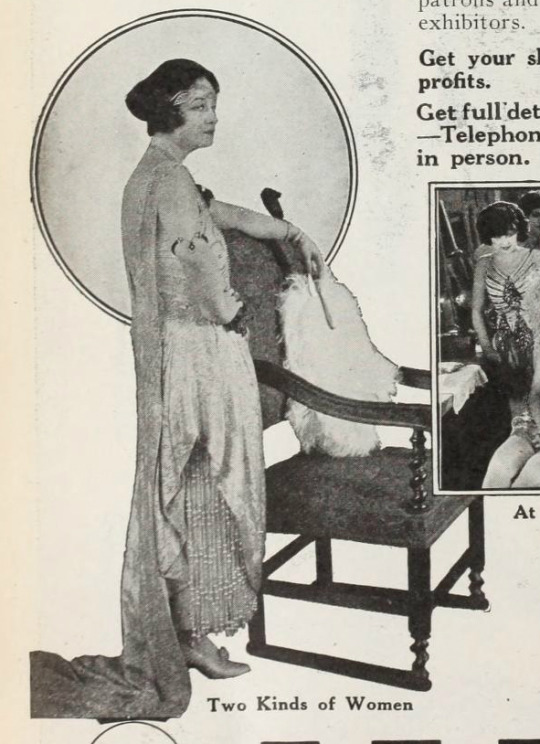
Judith is surprised to find an urgent note from Doc Tripp awaiting her after the dance. The note explains that he has uncovered another Trevors mole and has been wounded. Judith rushes to Tripp, but is waylaid and kidnapped. She manages to remove the mask from one of her abductors and it’s Trevors himself!
Three days pass. Hampton suddenly orders Carson to prepare 500 head of cattle to be sold at a loss. Immediately suspicious, Bud rides to the ranch house and is told that Judith left for San Francisco three days prior. Given Hampton’s fishy assumption of command, Bud and Carson tie him up while they investigate Judith’s real whereabouts. They discover the forged note and confirm with Tripp that he didn’t write it. With mistrust toward Hampton building, they place him under guard and ride to confront Trevors.

In all that time, Judith has been kept prisoner in the mountains by Quinnion. When Quinnion attacks her, Judith seizes an opportunity to escape, but quickly learns that her prison is set among perilous cliffs. Quinnion gives chase, they struggle, and he plummets to his death. Hopelessly lost and exhausted from her ordeal, Judith makes a last ditch effort for rescue by lighting a signal fire before losing consciousness.
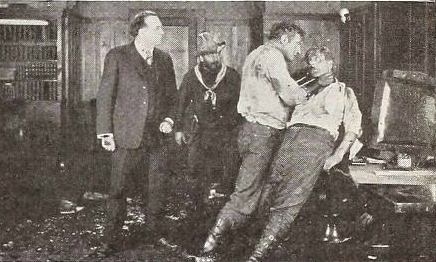
Bud and Carson find Trevors and a wild fist fight breaks out. Bud trounces Trevors and Trevors is forced to leave town for good, but not before revealing where he’s hidden Judith. Bud rescues Judith and they all return to the ranch. After they have had time to recover from their respective tribulations, Bud and Judith reunite and embrace.
——— ——— ———
Points of Interest:
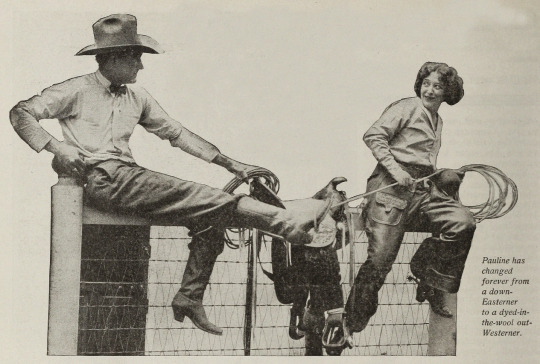
Pauline Frederick made 55 silent feature films in her career. Of those 55 films 45-6 of the films are presumed lost or mostly lost. [One film’s status is unclear ATM.] Of the 9 known to survive, 3 are incomplete (2 are missing at least one reel and the 3rd survives in an abridged cut). Of the surviving 9, three have had home video releases [Three Women (1924), Devil’s Island (1926), and Smouldering Fires (1925)]. Of the 6 surviving films that haven’t had home-video release, 2 have been screened publicly in the past decade [The Love the Lives (1917) and The Moment Before (1916)]. A very rough record for a big star (who didn’t spend most of their career at Fox) to only have a 16-18% survival rate.
——— ——— ———
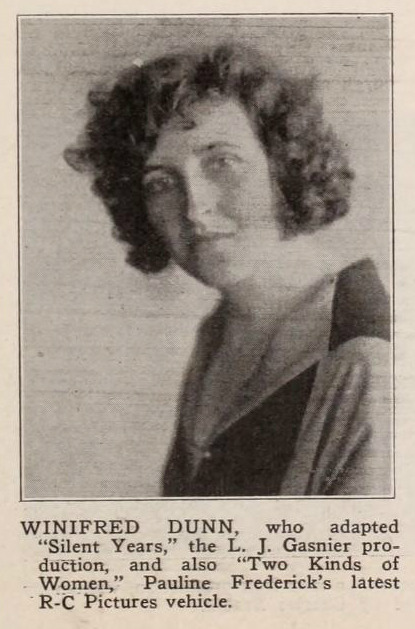
Winifred Dunn, prolific writer from a young age working in many genres, wrote/edited 33 silent features, 20 of which are presumed lost.
——— ——— ———
Two Kinds of Women was part of the schedule of R-C Pictures’ releases for early 1922. This was a crucial moment in the history of the company, as it was soon after re-organized into F.B.O. The founders exited the company, but so did Pauline Frederick, Sessue Hayakawa, Tsuru Aoki, and Doris May—their biggest stars going into 1922.
While the contemporary critical response to TKoW was generally positive and exhibitors across the US and Canada cited good ticket sales, it didn’t leave much of a legacy. At least one contemporary critic, Laurence Reid, considered the film of decent quality but ultimately forgettable. Whether TKoW would have stood the test of time or not, we can’t know. Lost or not, I’m sure the re-organization of TKoW’s distributor affected its potential for long-term popularity. There is at least one instance from after the re-org of a theatre owner receiving a faulty print of the film. So, even by 1923, it was hard to come by a decent print of TKoW.
The reason I’m confident in placing blame on R-C/F.B.O. is that, of the slate of 20 films they released in late 1921 and early 1922, 16 are currently presumed lost and only 3 appear to be completely extant:
Lost: The Lure of Jade, The Sting of the Lash, The Foolish Age, Eden and Return, Five Days to Live, The Vermillion Pencil, A Wife’s Awakening, Silent Years, The Call of Home, The Barricade,Two Kinds of Women, Boy Crazy, Salvage, The Glory of Clementina, Gay and Devilish, and At the Stage Door Extant: Where Lights Are Low, The Swamp (would live to see this one BTW), and Beyond the Rainbow
☕Appreciate my work? Buy me a coffee! ☕
Transcribed Sources & Annotations over on the WMM Blog!
#1920s#1922#Pauline Frederick#film history#Winifred Dunn#western#silent cinema#lost film#silent era#cinema#classic cinema#classic movies#classic film#american film#film#silent film#silent movies#lost media#history#california#old hollywood
18 notes
·
View notes